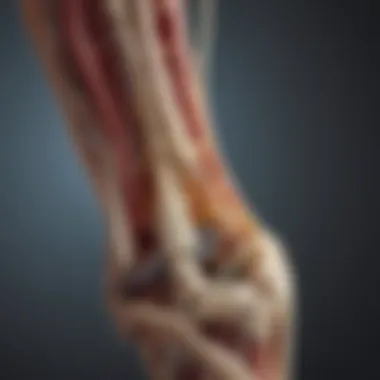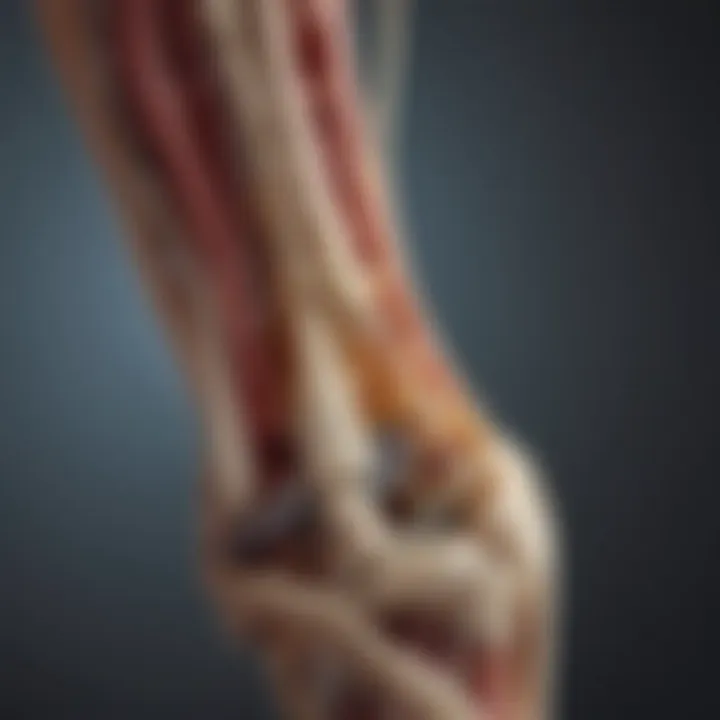Understanding Chronic Shin Pain: Causes and Management


Research Context
Background and Rationale
Chronic shin pain is a common issue faced by individuals involved in sports and physical activity. Understanding its causes is essential, as this condition can significantly impact performance, activity levels, and overall quality of life. Many athletes may experience shin pain at some point in their careers. This pain often leads to reduced participation in sports or exercise, resulting in physical deconditioning and emotional distress.
In many cases, chronic shin pain stems from mechanical stress on the bones, muscles, and tendons in the lower leg. Specific running techniques, foot structure, and even training methods can contribute to the development of chronic pain. Addressing these issues may prevent injuries and support recovery.
Literature Review
A systematic review reveals a plethora of research addressing chronic shin pain. Studies by Karp et al. (2020) and McCarthy et al. (2021) show a clear link between improper footwear and shin splints, a precursor to chronic pain. Other researchers like Smith et al. (2019) emphasize the importance of biomechanics in running and how these factors correlate with stress fractures. Existing literature effectively outlines the multifactorial nature of this condition, providing insights into prevention strategies, diagnosis methods, and treatment options.
Methodology
Research Design
The information collected for this article is derived from a comprehensive review of existing studies and publications regarding chronic shin pain. The approach combines qualitative and quantitative research methods. These methods allow for an in-depth exploration of the various factors associated with this condition.
Data Collection Methods
Data were collected from multiple sources:
- Peer-reviewed journals focusing on sports medicine.
- Clinical guidelines from organizations such as the American Academy of Orthopaedic Surgeons.
- Expert opinions from healthcare professionals specializing in sports-related injuries.
- Surveys conducted among athletes and fitness enthusiasts to gather anecdotal evidence.
Using these diverse sources enables a rounded understanding of chronic shin pain, from its origins to its management. This multifaceted approach provides valuable insights into the recurrent issues faced by individuals who participate in physical activity.
Preface to Chronic Shin Pain
Chronic shin pain represents a significant challenge, particularly for athletes and individuals engaged in physical activities. Understanding this condition is fundamental to recognizing its implications on performance and overall quality of life. This article examines chronic shin pain comprehensively, outlining its causes, diagnosis, and management strategies.
Definition and Significance
Chronic shin pain, commonly classified as pain lasting beyond four weeks, often originates from overuse or injury. The significance of this condition cannot be understated. It affects not only athletes but also recreational runners and even daily walkers.
Managing chronic shin pain is crucial for maintaining an active lifestyle. Ignoring these symptoms can lead to more severe injuries and long-term impacts on mobility. For example, untreated shin splints can progress to severe stress fractures, necessitating prolonged recovery periods.
Moreover, recognizing the condition's definition helps tailor effective treatment strategies. Clear definitions around shin pain, including its terminology, facilitate better communication between healthcare providers and patients.
Prevalence and Impact on Daily Life
Chronic shin pain is relatively common, especially among runners. Research indicates that approximately 10 to 20 percent of runners experience some form of shin pain at least once in their lifetime. The condition is not limited to runners; it can affect anyone participating in repetitive leg-based activities.
The impact of chronic shin pain on daily life is profound, leading to physical limitations, emotional distress, and lifestyle changes. Individuals may find themselves sidelined from their preferred activities, leading to frustration and potential mental health implications. For athletes, the inability to train can hinder performance goals and progress.
Furthermore, understanding the prevalence of this issue highlights the importance of education and prevention strategies. Increased awareness may encourage individuals to adopt better training habits, seek early intervention, and prioritize recovery.
In summary, the introduction to chronic shin pain serves as an essential foundation for further discussions on its diagnosis and management. Awareness, education, and understanding are crucial to mitigating risks and promoting healthier practices in physical activities.
Anatomy of the Shin and Surrounding Structures
The anatomy of the shin and its surroundings is a crucial foundation for understanding chronic shin pain. A comprehensive awareness of this anatomy not only assists in identifying potential pain sources but also supports effective management and rehabilitation options. Injuries in this region often stem from specific structural deficiencies or imbalances. Therefore, an appreciation of bone, muscles, tendons, and ligaments involved can greatly enhance diagnostic precision and treatment strategies.
Bone Structure and Function


The shin comprises primarily the tibia and fibula. The tibia, commonly known as the shinbone, is the larger and more weight-bearing bone, while the fibula runs parallel to it, providing stability and support. Bone structure in this area is critical for endurance during high-impact activities like running or jumping.
Proper function involves the tibia supporting body weight and acting as an anchor point for muscles and ligaments. Its robust design allows it to withstand significant stress. When there are structural issues, such as stress fractures related to overexertion or inadequate recovery, pain becomes more likely. Addressing bone health through nutrition and appropriate exercises is vital for maintaining this structure in good condition.
Muscles Involved in Movement
Several muscles contribute to the movement of the lower leg and foot. The key muscles include the tibialis anterior, gastrocnemius, and soleus.
- Tibialis Anterior: This muscle is located at the front of the shin. It plays a pivotal role in dorsiflexion, the action of raising the foot.
- Gastrocnemius and Soleus: These muscles form the calf. They are essential for plantarflexion, enabling the foot to point downwards and are engaged during activities like running and jumping.
Imbalances or weaknesses in these muscles can lead to improper movement patterns, resulting in added strain on bones and connective tissues. This understanding underscores the importance of targeted strength training to support muscle function, ultimately reducing injury risk.
Tendons and Ligaments
Tendons and ligaments are essential for connecting muscles to bones and stabilizing those connections.
- Tendons: The Achilles tendon is a prominent tendon in this area linking the calf muscles to the heel bone, allowing for powerful plantarflexion. Excessive strain on the Achilles can lead to conditions such as tendinitis, contributing to chronic pain.
- Ligaments: Ligaments in the shin region provide stability to joints, particularly the ankle joint. The anterior talofibular ligament is particularly vulnerable in cases of ankle sprains.
A thorough understanding of how these structures function and interact is essential. It can inform strategies for injury prevention and rehabilitation. Overall, detailing these components can help in discerning effective treatment pathways and creating tailored preventive measures for those experiencing chronic shin pain.
Common Causes of Chronic Shin Pain
Chronic shin pain is often a complex issue with a variety of underlying causes. Understanding these causes is crucial for effective management and prevention. By identifying the specific reason for the pain, individuals can tailor their treatments and rehabilitation efforts more accurately. This section will delve into the most common causes of chronic shin pain, highlighting their significance and implications.
Shin Splints: Overview and Mechanism
Shin splints, often medically referred to as medial tibial stress syndrome, is a prevalent cause of chronic shin pain primarily seen in athletes and runners. It occurs due to the overuse of the muscles, tendons, and bone tissue around the tibia. The pain typically manifests along the inner part of the shin and is associated with repetitive stress on the lower leg. Factors such as poor footwear, improper running techniques, or the transition to higher intensity workouts can exacerbate these symptoms. This makes awareness of shin splints essential for anyone engaged in physical activities.
Stress Fractures: Risk Factors and Symptoms
Stress fractures are tiny cracks in the bone often resulting from repeated stress and overuse. They most commonly occur in the tibia, particularly among those who engage in high-impact sports like running or basketball. Risk factors include sudden increases in training volume, improper footwear, and pre-existing bone conditions. Symptoms typically include localized pain that worsens with activity and improves with rest. Recognizing these signs early is important as untreated stress fractures can lead to more severe injuries.
Tendinitis: Types and Implications
Tendinitis around the shin area, particularly tibial tendinitis, is another common source of chronic pain. This inflammation can affect tendons near the shin bone due to repetitive strain. Symptoms may vary depending on the tendon involved and often include tenderness or stiffness in the lower leg. Delaying treatment can result in severe complications, including chronic pain and restricted mobility. Thus, understanding the different types of tendinitis and their implications helps individuals in seeking timely interventions.
Compartment Syndrome: Causes and Consequences
Compartment syndrome is a serious condition that arises when pressure builds up in the muscle compartments of the leg. This can occur due to increased activity levels or trauma. Symptoms include severe pain, swelling, and a feeling of tightness in the lower leg. Without urgent medical intervention, compartment syndrome can lead to lasting muscle and nerve damage. Understanding its causes and potential consequences is crucial for athletes and physically active individuals.
Other Contributing Factors
In addition to the primary causes mentioned above, other factors can exacerbate chronic shin pain. These include:
- Poor biomechanics, such as improper gait patterns.
- Overtraining without adequate rest and recovery time.
- Obesity, which increases the stress placed on the shin.
- Weak or inflexible muscles, particularly in the calves and feet.
A comprehensive assessment of these factors is important in developing a robust treatment plan. Addressing these secondary contributors can significantly enhance recovery and prevent future injuries.
Diagnostic Approaches for Chronic Shin Pain
Diagnosing chronic shin pain is a critical step in developing effective management strategies. The multifaceted nature of this condition demands a thorough understanding of its causes, allowing for targeted treatment options. Identifying the specific underlying issues can aid in pain relief, improving functionality and overall quality of life for those affected.
Clinical Evaluation


A clinical evaluation serves as the foundation for diagnosing chronic shin pain. During this assessment, healthcare professionals gather detailed patient histories. They explore physical activities and training habits, as well as pain characteristics like severity, duration, and triggers.
Physical examination follows history taking. Physicians inspect the shin area, looking for signs of tenderness, swelling, or deformities. Assessing range of motion in the affected limb is essential, as limitations can indicate specific structural problems. Functional tests may also be employed to evaluate the patient’s response to movement or pressure on certain areas. This systematic approach helps to delineate potential causes and guides subsequent diagnostic steps.
Imaging Techniques
Imaging techniques play a vital role in understanding the source of chronic shin pain. Two primary types of imaging are commonly utilized: X-rays and MRI scans.
- X-rays: These are useful for identifying stress fractures or bone abnormalities. However, they often miss soft tissue issues, so they are typically a first step in the imaging process.
- MRI scans: These provide a comprehensive view of both bone and soft tissue. They are particularly effective in identifying conditions like tendinitis or compartment syndrome, which X-rays cannot detect adequately.
Utilizing these imaging modalities can significantly enhance the diagnostic process. They provide visual confirmation of clinical findings and help rule out conditions that may present similarly.
Differential Diagnosis
Differential diagnosis is a crucial aspect of evaluating chronic shin pain. It involves distinguishing between various possible conditions that can cause similar symptoms. For instance, pain may stem from conditions such as shin splints, stress fractures, tendinitis, or compartment syndrome.
To achieve accurate differentiation, healthcare providers consider a range of factors, including:
- Pain Location and Quality: Specific pain patterns can point to particular issues.
- Activity History: Examining recent physical activities helps to illuminate possible overuse injuries.
- Response to Treatments: How the pain responds to initial treatments can offer valuable clues about its nature.
Accurate differential diagnosis is essential for effective treatment planning. Misdiagnosis may lead to inappropriate management, exacerbating symptoms and prolonging recovery.
In summary, the diagnostic approaches for chronic shin pain involve a comprehensive blend of clinical evaluation, imaging techniques, and differential diagnosis. Each element contributes to a clearer understanding of the patient's condition, enabling targeted management strategies that can effectively address the underlying causes.
Management Strategies for Chronic Shin Pain
Managing chronic shin pain is crucial for individuals looking to maintain an active lifestyle. This section highlights essential strategies that healthcare professionals utilize to address shin pain effectively. The aim is to restore function, reduce pain, and prevent recurrence, ultimately improving patients’ quality of life.
Conservative Treatment Options
Conservative treatments often serve as the first line of defense for managing chronic shin pain. These methods aim to alleviate symptoms without resorting to more invasive measures. Common approaches include:
- Rest: Allowing time for the inflamed tissues to heal is vital. Avoiding aggravating activities can hasten recovery.
- Ice Therapy: Applying ice can reduce inflammation and numb the pain temporarily. This is particularly effective after physical activity.
- Compression: Using compression sleeves or bandages can limit swelling and provide support to the affected area.
- Elevation: Keeping the legs elevated can ease swelling and improve blood circulation.
These methods are usually supplemented with modifications to activity levels and incorporating low-impact exercises like swimming or cycling.
Physical Therapy Interventions
Physical therapy is an integral part of managing chronic shin pain. A qualified physical therapist can develop a tailored exercise program that focuses on:
- Strengthening: Targeting specific muscles that support the shin and lower legs can prevent injury. Exercises may include calf raises and resistance training.
- Stretching: Flexibility exercises prevent stiffness. Common stretches involve calf stretches and shin stretches.
- Gait Analysis: Assessing walking or running patterns can identify biomechanical issues. Correcting these discrepancies can significantly reduce pain.
Through guidance and regular sessions, individuals often notice improvements in mobility and a reduction in pain.
Medication and Pain Relief
The use of medication may become necessary for managing chronic shin pain effectively. Common options include:
- Nonsteroidal Anti-Inflammatory Drugs (NSAIDs): Ibuprofen or naproxen can provide relief from pain and inflammation.
- Topical Analgesics: Creams or gels applied directly to the skin can help target local pain.
- Corticosteroid Injections: In some cases, a doctor might recommend injections to deliver anti-inflammatory medication directly where it is needed.
It is important to consult a healthcare provider before starting any medication to discuss potential side effects and interactions with other treatments.
Surgical Considerations


While surgery is generally considered a last resort for chronic shin pain, it may be necessary for severe cases. Surgical options can include:
- Release Procedures: For cases of compartment syndrome, surgery may relieve pressure on muscles and nerves.
- Decompression Surgery: This involves removing obstructions that prevent proper blood flow.
- Repair Procedures: Surgical intervention might be needed for severe tendon injuries or stress fractures that do not heal adequately with conservative methods.
Surgery should be approached carefully, as rehabilitation post-surgery is essential for success.
Managing chronic shin pain involves a holistic approach. Understanding individual needs and adapting strategies accordingly can lead to better outcomes and enhanced quality of life.
Preventive Measures for Shin Pain
Preventing chronic shin pain is crucial for maintaining optimal performance in activities such as running, sports training, and even routine physical tasks. By adopting specific strategies, individuals can minimize their risk of developing shin injuries. This section discusses critical elements, benefits, and considerations related to preventive measures.
Proper Footwear Selection
Choosing the right footwear is fundamental for preventing shin pain. Proper shoes provide adequate support and cushioning, reducing the stress on the shin area during impact. When selecting shoes, several factors should be taken into account:
- Arch Type: Understanding whether one has flat, neutral, or high arches can guide the choice of footwear.
- Cushioning and Support: Shoes must offer the right amount of cushioning tailored to an individual's running style or activity. For instance, runners may benefit from shoes that absorb shock well.
- Size and Fit: It's important to have a well-fitting shoe. Shoes that are too tight or too loose can lead to blistering or instability, exacerbating shin pain risks.
Investing in appropriate footwear can pay off in the form of reduced discomfort and better performance.
Training Techniques
Implementing effective training techniques can significantly lower the incidence of shin pain. A few approaches include:
- Gradual Progression: Increasing training intensity or duration slowly helps the body adapt, which reduces stress on the shins.
- Cross-Training: Engaging in low-impact activities, such as swimming or cycling, allows for physical conditioning without overstressing the shins.
- Rest Days: Incorporating rest days into training schedules enables muscle recovery and helps prevent overuse injuries.
Properly adjusted training regimens can effectively minimize the impact on the shins and foster long-term endurance and strength.
Strengthening and Flexibility Exercises
An often overlooked aspect of shin pain prevention is the implementation of targeted strengthening and flexibility exercises. These exercises can enhance the resilience of the muscles and tendons around the shin area. Key exercises include:
- Calf Raises: This strengthens calf muscles and enhances support for the shin.
- Toe Taps: Engaging the muscle in the front of the shin, this can improve mobility and strength.
- Stretching: Regular stretching of the calf and Achilles tendon can prevent tightness, which contributes to shin pain.
Incorporating these exercises into a regular fitness routine builds strength and flexibility, reducing the likelihood of injury.
Taking preventive measures is essential to maintaining activity levels and overall health. By understanding the significance of proper footwear, smart training techniques, and targeted exercises, individuals can protect themselves against chronic shin pain.
The End
The conclusion section is crucial as it provides a summary of the core concepts discussed throughout the article. Here, we reinforce the relevance of understanding chronic shin pain for athletes and physically active individuals. Knowing the causes, diagnostic approaches, and management strategies offers a foundation for preventing and treating this condition.
This article elucidates various key points related to chronic shin pain, emphasizing not only the medical aspects but also the personal impact on daily life and performance. By recognizing the symptoms, athletes can seek timely intervention and enhance their recovery process.
Moreover, effective management encompasses both treatment and prevention. It is essential for individuals to incorporate best practices into their training regimens. This promotes longevity in their physical activities.
An understanding of chronic shin pain can significantly improve the quality of life, resulting in better performance and fewer setbacks. Therefore, the significance of this conclusion extends beyond summarization; it serves as a beacon for those navigating the challenges associated with this prevalent condition.
Recap of Key Points
- Chronic shin pain affects a wide range of people, particularly athletes and runners.
- Recognizing the different causes—such as shin splints, stress fractures, and tendinitis—is essential for effective management.
- Various diagnostic methods exist, including clinical evaluations and imaging techniques, to accurately identify the source of pain.
- Management strategies are varied, including conservative treatments, physical therapy, and in some cases, surgical interventions.
- Preventive measures such as proper footwear, training techniques, and regular flexibility exercises can help mitigate risk.
Future Directions for Research
Research on chronic shin pain continues to evolve. Future studies should focus on understanding the long-term implications of active management strategies. Key areas for exploration include:
- Assessing the impact of personalized training programs on injury prevention.
- Investigating the efficacy of newer imaging technologies in diagnosing related conditions.
- Exploring the role of cross-training in reducing the incidence of shin pain.
- Evaluating the psychological aspects of chronic pain and its impact on recovery.
In enhancing our understanding of chronic shin pain, we not only optimize treatment but also contribute valuable knowledge to the field of sports medicine. Advancements in research can lead to better outcomes for athletes and recreational enthusiasts alike.



